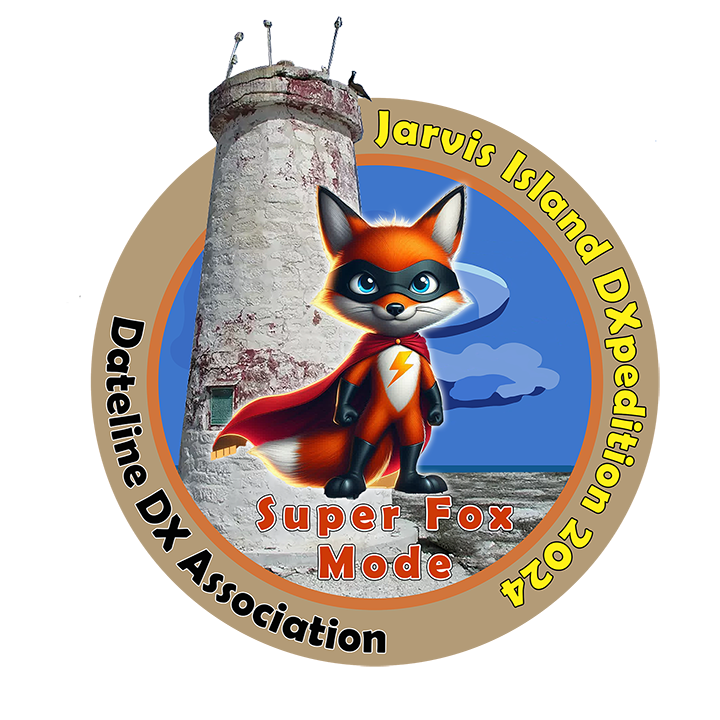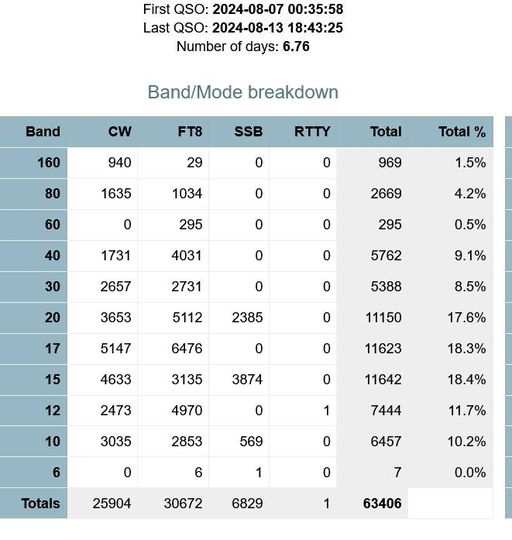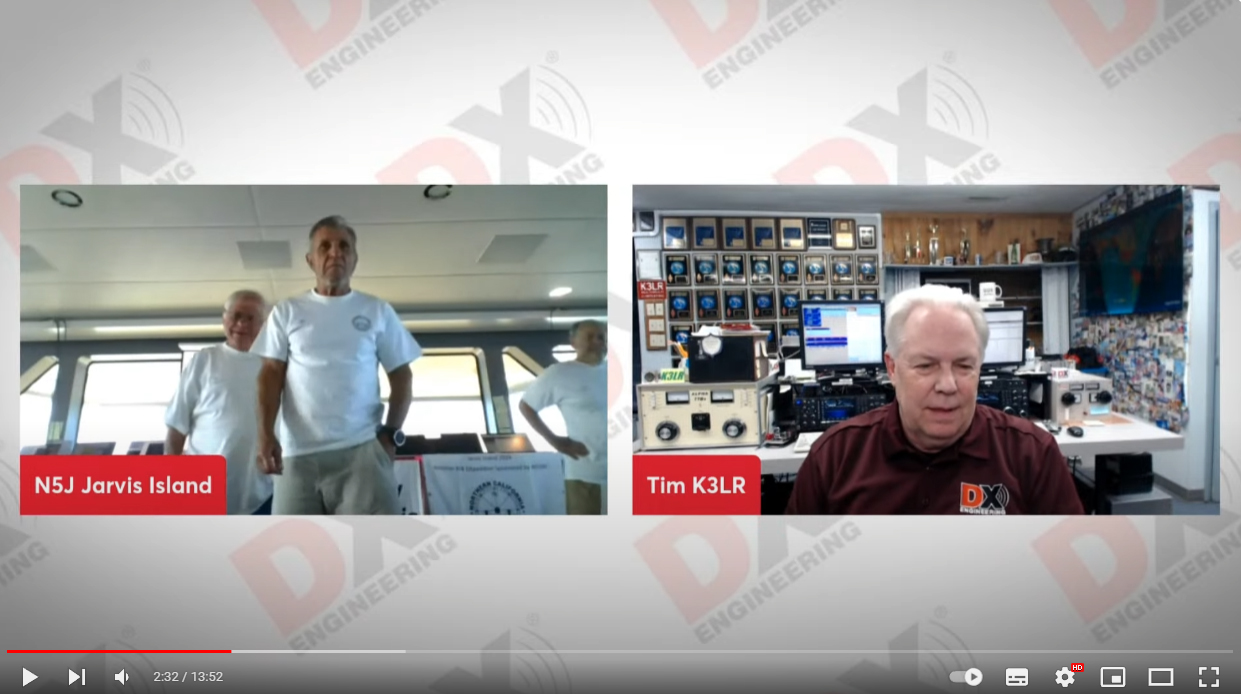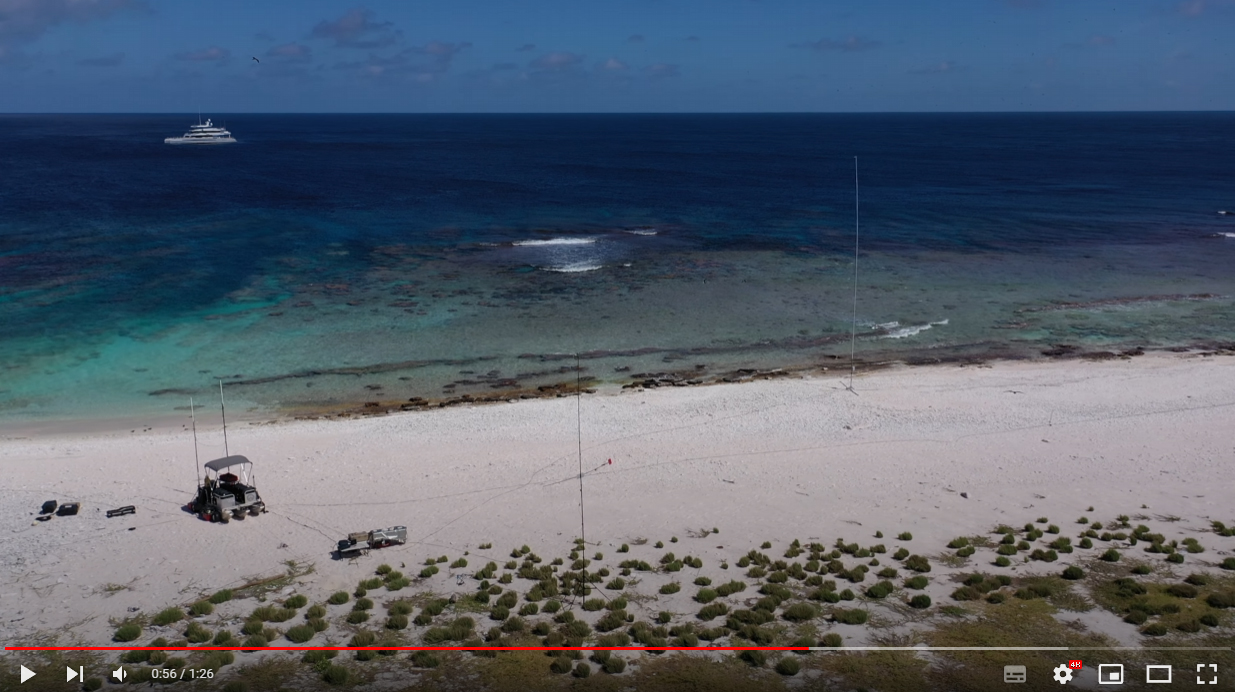![]() By N1DG
By N1DG
I am writing this on the way to Pago Pago from Jarvis Island. What a ride! No, I don’t mean the storm we just went through which had winds peaking at 68 knots (hurricane strength). The trip to Jarvis really began eight years ago right after the successful Baker Island DXpedition where we tried to keep a few operators on the ship and remote to the radios on the island. The remote idea was a total failure yet the DXpedition was a great success except that it left the team totally exhausted.
At 17:00 UTC the team is headed to the Island to begin the teardown.
The first thing to go is the link to the Island so full QRT at once.
Thank you all for the QSOs. It was a blast.
Full recap after we get the Island clean and some sleep.
Don, George and the N5J team
The last two nights we have been able to work CT and EA stations, both on FT8 and CW, between 0500 and 0530 UTC.
We will be on 1828.5 every night from 0445 to 0530. (Listening up.)
GL and 73,
George
 In response to the requests to run normal Fox Hound mode because some stations are having difficulty with the SuperFox mode, effective 00:00 UTC 16 August we will convert one of the two WSJT-X stations to the old Fox Hound method.
In response to the requests to run normal Fox Hound mode because some stations are having difficulty with the SuperFox mode, effective 00:00 UTC 16 August we will convert one of the two WSJT-X stations to the old Fox Hound method.
We ask all stations who already worked us in the digi band mode to let those people still needed a digital QSO to work us. Check clublog if you are unsure.
We will still have another station in Superfox mode.
We hope this allows more stations to make it into the log on digi or even an ATNO.
Thanks for all the QSOs.
The N5J team.
We have been improving our 160 m set up every day. We have added more ground wires that connect the TX antenna base to the water and have built a very effective RX antenna. Now we can comfortable hear most callers.
Last night we got on 160 first around 0530. There were a few NA, callers. Most had 100% QSB: going from 5 CPY to nothing in seconds. Got back on TB around 0830. Signals were much steadier with a slow but continuous stream of NA callers. TS noise started up around 0900 and got steadily stronger all night. (This noise comes from T storms in the Solomons, Papua and Indonesia, reaching us after their SS. It gets progressively worse as the night progresses.
We are at the 1000 TB QSO mark. Given the fact the Aug is about the worst time of the year for 160, this is OK. There would be many more in the log if callers used better tactics:
1. Send your call twice. We need narrow filter settings because of the noise (we are on the Equator). Unless you are "tail-gating" it takes time for us to tune the RX to the caller's frequency. Often we only get the last few letters of the call ... and then wait. If we CQ again, another caller will jump in and the first caller will lose the Q. This happens a lot. If you are tail-gating -- calling on the last Q-s frequency -- once is enough!
2. There are callers who are not hearing us. We keep on replying with no result. Probably most people listening on our TX frq can hear this taking place. Sure, QSB and QRM will often make two or three attempts necessary. But there have been some to whom I have replied to dozens of times over many hours. They are just causing QRM and wasting their time as they will not make into the log by accident.
3. Insurance QSO-s are perfectly justified. But they make no sense the third, fourth -- and sometimes the sixth time. If we are not busy, a dupe call is welcome as it reassures us that the band is still open. But when there is a pile up, a third insurance Q just takes someone else's Q.
4. JA-s tend to have this habit (not all, TKS). It springs from good intentions, but... When calling they send their call only once. We often catch only part of it, just like in point 1. But once we reply with the correct call. they then come back sending their call three times. This gets us to the next point:
5. The ideal sequence is: CQ N5J UP -- N4xx N4xx --- N4xx 5NN -- 5NN TU -- TU. Sending the call ahead of the 5NN can create doubt under difficult RX conditions. Sending 5NN is really a confirmation that tells the operator that the callsign is correct. The TU further confirms that the QSO is good and can go into the log. Less is more!
6. For NA callers: JA callers have an all-water path to us and are often louder. They start coming in after 1000 Z, some with astonishingly strong signals. Plan you time accordingly: waiting for your SR-bump may not be worth it if it puts you in competition with stronger (and numerous) signals.
7. Actual signal reports are very welcome. (Even the 339 ones.) They help us adjust to the conditions.
We will keep coming on around 0500 for a short time -- there is a tiny chance of working EU. And then come on again around 0830 ahead of NA SR. During the next few nights we will also work FT8 F/H. It seems that SuperFox, which has been very effective on other bands, it not as good under poor conditions on TB. Hence F/H.
TKS for all the calls and GL,
George,
N5J
 N5J has completed 6 days of operating.
N5J has completed 6 days of operating.
The log shows over 63,000 QSOs despite some really terrible conditions.
Are you still having trouble working the Superfox?
Many Hounds are still chasing us on Superfox using RC5. Psk reporter shows versions. We looked today at the spots. Of 7500 reports 1500 were still using RC5.
They are NOT in the log. Please update your software. Poor conditions also chop up the Fox signal. We will operate some F/H on one of the 2 FT8 stations this coming weekend.
The N5J team.
The N5J DXpedition is now underway on all bands and mode.
We expect to be QRV until the 20th of August weather permitting.
GL in the pileups.
The N5J team
The Magnet, with the N5J team and three USFWS scientists on board, got under way at 0500 AM from American Samoa for Jarvis island. The time required to cover the distance of 1050 Nautical Miles (1940 km) depends on the boat-speed that we are able to maintian. Currently we are cruising at 15 knots (27 kmph) in light winds and moderate seas (waves of 3 to 5 feet). According to the forecast this favorable weather should continue for the next three days. Although we are likely to encounter some opposing currents, we expect to arrive at Jarvis the morning of August 6. If for some some reason we need to slow down, we will time our arrival for the morning of the 7th.
After a successful test operation in preparation of Jarvis we are dismantling the antennas today and going QRT. Final logs will be posted to clublog tonight.
Superfox performed much better than we’ve ever seen F/H do and we experimented with many qrp stations.
We expect to depart for Jarvis on August 2 and are watching a storm which could change plans.
See you from N5J and thanks for the QSOs.
The N5J team

